 |
CHAMÄLEON + ONJALA OBSERVATORY Moon images 07/8 + 09 2018 | SITEMAP HOME |
|
 |
|||
All surface structures (craters, mountains etc.) described in the texts are labeledin the images. Click on the respective thumbnail to load a large image. The images are opened in a separate browser window. « HOME Mosaic Images 2018 |
|
|||||||||||
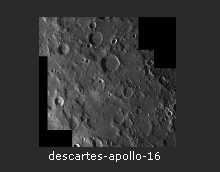 |
The Descartes Highlands - landing site of
Apollo 16 The image shows the region of the Descartes Highlands, landing area of the Apollo 16 mission. The small red dot marks the landing position, directly south of it (in the picture above) the image shows the bright ray system of the small crater "south ray". Southeast lies the Descartes SWIRL, a region with a strong magnetic field anomaly. Besides Reiner Gamma in the Oceanus Procellarum, this is the only SWIRL on the nearside of the moon. At the top of the image (south) is the beautiful symmetrical Abulfeda crater from which the impressive Catena Abulfed crater chain joins southeast. |
| To the west of Abulfeda lie the two strangely shaped craters Ritchey and Ritchey J, which are certainly results of multiple impact. | |
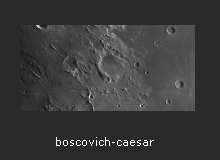 |
The Caesar crater, the Boscovich region and
Rima Ariadaeus In the center of the image is the 90km large crater Julius Caesar. To the west is Boscovich with a diameter of 46km. The Rimae Boscovich lie on the smooth, dark crater floor. South of Caesar lies the 220km long and up to 7km wide groove Rima Ariadaeus, probably a depression. The whole region is characterized by lunar volcanism. To the west (right) of Boscovich lies a large region with pyroclastic ash deposits, the Pyroclastic Mare Vaporum. At the upper edge of the picture is the crater Hyginus, which is not an impact crater but a volcanic caldera. South of Caesar lies the large volcanic dome Julius Caesar 1 with a size of approx. 26km. |
| North and west (in the picture below and to the right)
is characterized by the so-called Imbrium Sculpture. The lunar surface is
characterized by structures lying diagonally in the picture. The orientation
points directly to the center of Mare Imbrium and the region is certainly
characterized by the Imbrium Impact. The orientation of these radial structures
can be followed up to the large craters Ptolemy and Alphonsus. |
|
 |
Northwest wall of Mare Crisium and
Macrobius North and west (in the picture below and to the right) is characterized by the so-called Imbrium Sculpture. Parallel to the rim lies the ridge Dorsum Oppel. At the top of the scene is the 31km large Lick crater with a volcanically convex crater floor, grooves and small craters. Following to the north is the 36km large Yerkes crater which is almost filled with lava up to the eastern crater wall. Directly west of it lies a large volcanic bulge with a system of grooves, Yerkes 1. Proclus, the crater with the asymmetric ray system at sunrise and further north lies the 65km large crater Macrobius in Lacus Bonitatis. |
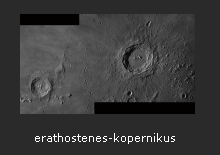 |
The crater Erathostesnes, Copernicus and
Stadius The scene shows the young, nearly 100km large crater Copernicus, east of it the "ghost crater" Stadius and Erathostenes (58km). On the crater floor of Kopernikus you can clearly see the different soil conditions. The northwestern part is relatively smooth, the rest is "hilly". Also the different terraces (landslides) of the inner crater wall are clearly visible. Stadius is an ancient crater that is literally filled up from the Copernikus ejecta material to the crater rim. The smaller craters that cover Stadius and lie further north are secondary craters formed by Copernikus impakt. |
 |
Rimae Triesnecker, Rima Hyginus,
Ukert, Pallas und Murchinson Stadius is an old crater, which is literally filled up from the ejecta material to the crater rim. While Triesnecker is a normal impact crater and the grooves are stress fractures, Hyginus is a volcanic caldera and the groove is a former lava flow channel. To the south lies the large "pyroclastic" Mare Vaporum region, which is covered with volcanic ash. In the Murchinson crater lie two larger volcanic shield volcanoes (circular labeled). |
| To the north, the Ukert crater, with its clearly
triangular shape, lies in a region clearly marked by the impact of the Mare
Imbrium. The diagonal structures point directly to the centre of Mare Imbrium
and can be traced to the region of the great craters Ptolemy and Alphonsus.
|
|
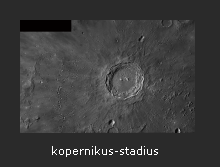 |
Copernikus and
Stadius Stadius is an old crater, which is literally filled up to the crater rim by the ejecta material of the Copernikus impact. The smaller craters, which cover Stadius and lie further north, are secondary craters that were formed by the Copernicus Impact. North and south of Copernicus lie two so-called dark halo craters (DHC). The southern one (in the image above) has a diameter of 4.5km, the smaller one north of Copernicus has a diameter of just 2km. West of the larger one is the small double crater Fauth. |
 |
The Mare
Australe The image is a mosaic of 3 and shows the complete Mare Australe under ideal libration conditions. The picture shows the 80km big crater Oken and the 140km big crater Lyot. Both show dark crater bottoms. The Mare Australe is not a continuous lava surface similar to the Mare Imbrium or the Mare Tranquilitatis, but consists of a number of several lava surfaces. |
 |
Maurolycus, Stoeffler and
Heraclitus A view into the chaotic highlands of the moon. The two large craters Maurolycus and Stoeffler characterize the scenery. The impact that created the crater Faraday occurred after the impact of Maurolycus. The bright areas on the crater floor of Stöffler are ejecta material from the crater Tycho. South of Stöffler lies the elongated crater Heraclitus, which is certainly the result of a multiple impact. The craters Cuvier, Licetus and Heraclitus D were formed later than the formation of Heraclitus. |
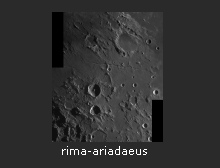 |
Rima Ariadaeus, Godin and
Agrippa In the center of the image is the 220km long and up to 7km wide groove Rima Ariadaeus. It is probably - similar to the alpine valley - a depression and not of volcanic origin. To the north are the craters Julius Caesar and Boscovich with its groove system and unusually dark crater floor. North of the eastern end of Rima Ariadaeus lies the unusually large shield volcano Ariadaeus 1 with 28 x 14 km. |
| In the south are the two large craters Godin (35km) and Agrippa (46km). The eastern end of Rima Hyginus is located in the middle at the right edge of the picture. | |
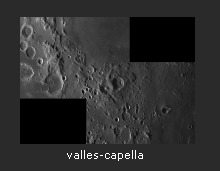 |
Vallis
Capella In the center of the image are the Capella and Isidoris craters of approximately the same size. Diagonal the crater Capella crosses the Vallis Capella. It is not a valley, but a very old chain of craters older than Capella. The crater interrupts the crater chain and Capella must be younger. The central mountain of Capella has an unusual shape. Southeast of Capella lies a volcanic region. The inside of Gaudibert crater is filled with swollen lava and further south is the volcanic ash region "Pyroclastic" Gaudibert B. |
| Northwest of Capella and Isidoris lies the strange crater Torrichelli, which is the result of a very flat impact . To the east is a volcanic dome with very steep slopes (circle labeled). | |
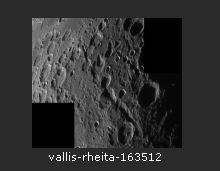 |
Vallis Rheita The image shows centrally the Vallis Rheita at sunrise. Like the Vallis Capella, the Vallis Rheita is not a valley but a chain of impact craters. Probably there are even two different crater chains, because at crater Young D the direction of the craters changes. At the top left of the picture are the western margins of the Mare Australe. |
| top of page | |
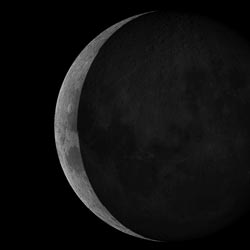 |
 |
 |
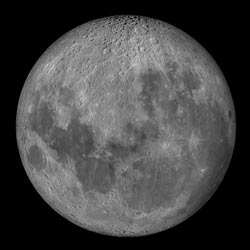 |
| 0 to 3 Tage - 0 to 10
% |
4 to 7 Tage - 11 to 50 % | 8 to 10 Tage - 51 to 74 % | 11 to 14 Tage - 75 to 100 % |
 |
 |
 |
 |
 |
 |
 |
| Sun | Moon | Solar System | DeepSky | Widefield | Miscellaneous | Spec. Projects |

